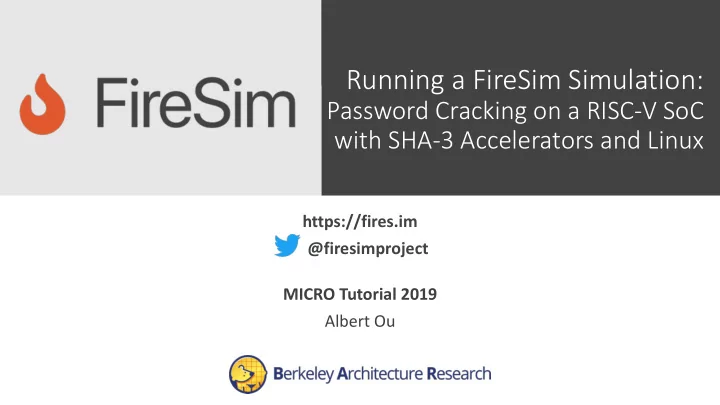

Running a FireSim Simulation: Password Cracking on a RISC-V SoC with SHA-3 Accelerators and Linux https://fires.im @firesimproject MICRO Tutorial 2019 Albert Ou
Agenda • Configure and launch a simulation runfarm • Boot Linux interactively on the target hardware • Deploy new automated workloads • Stress the SHA-3 accelerator that you integrated earlier with a complex Linux application (John the Ripper) 2
Tutorial Roadmap Custom SoC Configuration FireMarshal RTL Generators Bare-metal & RISC-V Multi-level Custom Accelerators Peripherals Linux Cores Caches Verilog Custom Workload RTL Build Process FIRRTL FIRRTL IR Verilog QEMU & Spike Transforms Software RTL Simulation FireSim FPGA-Accelerated Simulation Automated VLSI Flow Tech- Tool- VCS Verilator Simulation Debugging Networking Hammer plugins plugins
Prerequisites • Interactive shell commands intended to be run during the tutorial are highlighted in blue blocks (prefixed by “ $ ”) • Some simplifying assumptions about the shell environment: • The FDIR variable refers to FireSim’s top directory • You have sourced the sourceme-f1-manager.sh setup script • The default .bashrc already sets up everything for you $ export FDIR=~/chipyard-afternoon/sims/firesim $ cd $FDIR $ source ./sourceme-f1-manager.sh 4
Runtime Configuration What to simulate and what infrastructure is required is controlled by $FDIR/deploy/config_runtime.ini • Target-level: Assemble a simulated system from components • FPGA images of SoC hardware designs • Network topology • Workload definition • Host-level: Specify which EC2 instances to use 6
config_runtime.ini The [runfarm] section specifies the number, type, and other launch parameters of instances to be managed [runfarm] runfarmtag=mainrunfarm f1_16xlarges=1 m4_16xlarges=0 f1_4xlarges=0 f1_2xlarges=0 runinstancemarket=ondemand spotinterruptionbehavior=terminate spotmaxprice=ondemand 7
config_runtime.ini The [targetconfig] section specifies the high-level configuration of the system to simulate [targetconfig] topology=example_8config no_net_num_nodes=2 linklatency=6405 switchinglatency=10 netbandwidth=200 profileinterval=-1 defaulthwconfig=firesim-quadcore-nic-l2-llc4mb-ddr3 defaulthwconfig references an entry from config_hwdb.ini 8
config_runtime.ini The [workload] section specifies the software to be executed on the simulated nodes [tracing] enable=no startcycle=0 endcycle=-1 [workload] workloadname=linux-uniform.json terminateoncompletion=no [tracing] configures the trace port capture, which will be explained further during the debugging session 9
Testing Your New AGFI • By now, the buildafi run that you started at the very beginning of this tutorial should have finished • Add your HWDB entry to config_hwdb.ini : $ cd $FDIR/deploy $ cat built-hwdb-entries/firesim-singlecore-no-nic-l2-lbp >> config_hwdb.ini • Verify that it follows this format (The unique AGFI ID will be unique): [firesim-singlecore-no-nic-l2-lbp] In case you did not build the AGFI in agfi=agfi-0cf1114522235cca0 time, a pre-populated entry is deploytripletoverride=None provided for you to use customruntimeconfig=None 10
Single-Node Simulation • Edit config_runtime.ini to match the following settings • Change only these lines – leave the others unmodified! • Use a smaller f1.2xlarge instance (1 FPGA) [runfarm] • Simulate one non-networked node without a switch model f1_16xlarges= 0 • Load the single-core Rocket design without a NIC f1_2xlarges= 1 OnlyONL CHANGE HET [targetconfig] topology= no_net_config no_net_num_nodes= 1 defaulthwconfig= firesim-singlecore-no-nic-l2-lbp
Launching Simulation Instances $ firesim launchrunfarm FireSim Manager. Docs: http://docs.fires.im Running: launchrunfarm Waiting for instance boots: 0 f1.16xlarges Waiting for instance boots: 0 f1.4xlarges Waiting for instance boots: 0 m4.16xlarges Waiting for instance boots: 1 f1.2xlarges i-0a42dfd6edd081d10 booted! The full log of this run is: /home/centos/chipyard-afternoon/sims/firesim/deploy/logs/2019-10-07--05-14-31- launchrunfarm-JNWXEVMP49H036E7.log 12
Deploying Simulation Infrastructure $ firesim infrasetup This deploys various software prerequisites: • Builds host-side simulation drivers for the specific build triplet • Builds the switch model executable (if enabled) • Collects information about simulation instances and transfers files • Builds and loads the XDMA kernel driver • Programs the FPGAs with the desired AGFIs 13
Deploying Simulation Infrastructure $ firesim infrasetup FireSim Manager. Docs: http://docs.fires.im Running: infrasetup Building FPGA software driver for FireSimNoNIC- L2SingleBank512K_DDR3FRFCFSLLC4MB_FireSimRocketChipSingleCoreConfig-BaseF1Config_F75MHz [192.168.3.142] Executing task 'instance_liveness ’ [192.168.3.142] Checking if host instance is up... [192.168.3.142] Executing task 'infrasetup_node_wrapper ’ [192.168.3.142] Copying FPGA simulation infrastructure for slot: 0. [192.168.3.142] Installing AWS FPGA SDK on remote nodes. Upstream hash: 6c707ab4a26c2766b916dad9d40727266fa0e4ef [192.168.3.142] Unloading XDMA/EDMA/XOCL Driver Kernel Module. [192.168.3.142] Copying AWS FPGA XDMA driver to remote node. [192.168.3.142] Unloading XDMA/EDMA/XOCL Driver Kernel Module. [192.168.3.142] Loading XDMA Driver Kernel Module. [192.168.3.142] Clearing FPGA Slot 0. [192.168.3.142] Checking for Cleared FPGA Slot 0. [192.168.3.142] Flashing FPGA Slot: 0 with agfi: agfi-08ede528844cc6f2d. [192.168.3.142] Checking for Flashed FPGA Slot: 0 with agfi: agfi-08ede528844cc6f2d. [192.168.3.142] Unloading XDMA/EDMA/XOCL Driver Kernel Module. [192.168.3.142] Loading XDMA Driver Kernel Module. [192.168.3.142] Starting Vivado hw_server. [192.168.3.142] Starting Vivado virtual JTAG. The full log of this run is: /home/centos/chipyard-afternoon/sims/firesim/deploy/logs/2019-10-07--05-16-52-infrasetup-FR2TRJII9LPN1NSL.log 14
Custom FireSim Workloads • Workload : Series of jobs (software configurations) assigned to run on individual simulations • Two types of workloads: Uniform : Homogenous job run by all nodes in a simulated cluster Non-uniform : Each node is assigned a different job • Client/server configurations • Benchmark suites (SPEC17) 15
Workload Definitions • This example uses “ linux- uniform” as the simulated workload • These JSON files live in $FDIR/deploy/workloads/*.json { "benchmark_name" : "linux-uniform", "common_bootbinary" : "br-base-bin", "common_rootfs" : "br-base.img", "common_outputs" : ["/etc/os-release"], "common_simulation_outputs" : ["uartlog", "memory_stats.csv"] } • $FDIR/deploy/workloads/linux-uniform/br-base{-bin,.img} are symlinks to the FireMarshal-generated images 16
SPEC CPU2017 { • 10 jobs – one per benchmark in "common_bootbinary" : "bbl-vmlinux", "benchmark_name" : "spec17-intrate", the SPECrate Integer suite "deliver_dir" : "spec17-intrate", • No time in this tutorial, but the "common_args" : ["--copies 4"], "common_files" : ["intrate.sh"], general procedure is: "common_outputs" : ["/output"], "common_simulation_outputs" : ["uartlog"], • Build the spec17-* target in "workloads" : [ $FDIR/deploy/workloads/ { "name": "500.perlbench_r", Makefile "files": ["500.perlbench_r"], • Set the workload to spec17- "command": "cd /spec17-intrate && ./intrate.sh 500.perlbench_r", intrate.json in "simulation_outputs": [], "outputs": [] config_runtime.ini , set the }, f1_2xlarges=10 , select the { hardware config to benchmark, "name": "502.gcc_r", "files": ["502.gcc_r"], then "command": "cd /spec17-intrate && ./intrate.sh 502.gcc_r", firesim/launchrunfarm/ "simulation_outputs": [], infrasetup/runworkload "outputs": [] }, … ] } 17
Running the Simulation $ firesim runworkload FireSim Manager. Docs: http://docs.fires.im Running: runworkload Creating the directory: /home/centos/chipyard-afternoon/sims/firesim/deploy/results- workload/2019-10-07--05-35-00-linux-uniform/ [192.168.3.142] Executing task 'instance_liveness ’ [192.168.3.142] Checking if host instance is up... [192.168.3.142] Executing task 'boot_switch_wrapper ’ [192.168.3.142] Executing task 'boot_simulation_wrapper ’ [192.168.3.142] Starting FPGA simulation for slot: 0. [192.168.3.142] Executing task 'monitor_jobs_wrapper' 18
Recommend
More recommend